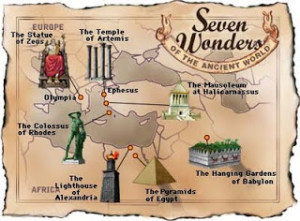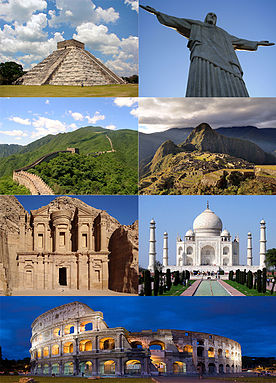Most of us have heard of the Seven Wonders of the World. They’ve even crept into common language. Have you ever heard someone refer to something amazing or incredible as the ‘Eighth Wonder of the World?’ I often use this turn of phrase when referring to the ostentatiously equipped newest middle school in my town, although it’s more a reflection of my cynicism than wonder. But I digress – not a surprise for those veterans of this blog – let me get back to the Seven Wonders.
Though none of his writings have survived, the later works of Strabo, Antipater of Sidon, and Philo of Byzantium credit Herodotus with creating the original list of wonders. To save you some time (and keep you from leaving my blog page) here’s his list: 
- Great Pyramid of Giza
- Hanging Gardens of Babylon
- Statue of Zeus at Olympia
- Temple of Artemis at Ephesus
- Mausoleum at Halicarnassus
- Colossus of Rhodes
- Lighthouse of Alexandria
Could you name all of them? I only got six. I always seem to forget the Temple of Artemis. Of these, barring time-travel (to the past for you nitpickers) the only wonder that you can see is the Great Pyramid of Giza. The only thing it’s missing is its white stone facing, which was removed in the 14th century. A combination of archaeological evidence and written records confirm the existence of five of the others – the exception being the Hanging Gardens. Fire claimed the Temple of Artemis and the Statue of Zeus, while earthquakes destroyed the other three. Surviving bits and pieces include sculptures from the Mausoleum and the Temple of Artemis in the care of the British Museum.
One can certainly quibble about a list of World wonders that apart from the Hanging Gardens, doesn’t include anything beyond the Eastern Mediterranean. Quite a few revised and updated lists of the Seven Wonders of the World have been compiled. The Romans included the Colosseum, while Christian monks added Noah’s Ark and Solomon’s Temple. Others have added the Leaning Tower of Pisa, the Great Wall of China, and Stonehenge to their lists. Expanding the idea beyond buildings, there are now lists of seven wonders for civil engineering projects, nature, the industrial world, and even the solar system. One of my favorite computer games, Civilization, updates its list of great wonders players can build with every new release.
This proliferation of new wonders and lists led Bernard Weber and the New7Wonders Foundation to use polling to create a new list. From 200 existing monuments (conveniently eliminating six of the original seven) a list of 21 finalists was selected. Over 100 million votes were cast to select the seven new wonders, with the following results:
- Great Wall of China
- Petra
- Colosseum
- Chichen Itza
- Machu Picchu
- Taj Mahal
- Christ the Redeemer
- Great Pyramid of Giza
You neither miscounted the previous sentence nor has reading this post turned your brain to mush. There are eight wonders on the list. In an odd twist, the only one of the original seven wonders still standing was added as an honorary member, making the oldest of the wonders the eighth New Wonder of the World.
Like its predecessor, the new list has no official standing or recognition. However since its release in 2007, pop culture has adopted it. The UK show, An Idiot Abroad, documents the travails of Karl Pilkington as he visits all Seven New Wonders. The show includes the Great Pyramid and drops the Colosseum, which is missing from the latest version of Civilization.
In keeping with my desire to weave history into my YA fantasy books, the pyramids also make a cameo appearance in Misaligned.
Excerpt from Misaligned: The Silver Scepter:
After exchanging pleasantries, Mary said, “So I understand that this new exhibit’s going to be about the pyramids. Tell me something about the pyramids that most people wouldn’t know.”
“Most people think that the pyramids were built with slave labor, but that’s really not true,” said Grace.
“You mean Ben Hur and the rest of those Hollywood movies got it all wrong?” asked Mary with as much sarcasm as she could muster.
“I’m afraid so. While there were close to one hundred thousand people working on Khufu’s pyramid at Giza, they only worked during the three months of the Nile’s annual flood. During those months, it was impossible for them to work the land, so while they worked on the pyramid, Khufu provided them with food and clothing.”
You’ll need to read the rest of the story to learn even more interesting facts about the Great Pyramid and find out how I connect this to a story about String Theory and the Welsh origins of Arthurian legend.
As always thanks for reading.
Armen
For more information on the Misaligned series, please visit my website Misaligned Info


I wouldn’t worry about it, Rick. It’s not the type of thing that comes up in many casual conversations. I thought it interesting that the New Wonders project generated more than 100 Million votes – the most ever in an internet poll (they did restrict voting to one per unique device). As always, I appreciate you taking the time to read and comment.
I got the Hanging Gardens, the Pyramids (not quite right) and, I thought, the Tower of Babel and the Wall of China. Really a rather poor showing of my own knowledge of history. …..Thanks. Very interesting.
FOOD for thought…and P.B.S. specials, anyway!
Jonathan,
You’re right. I’m surprised I haven’t seen one on PBS. Perhaps I just missed it. Thanks for reading.
Armen